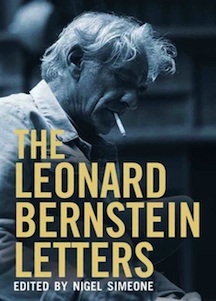By Carey Wall
Leonard Bernstein, conductor, pianist and composer, was also a great correspondent, keeping in touch with a multitude of relatives, friends, collaborators, and would be collaborators. This volume is misnamed, for as Simeone points out, it presents only a selection of letters by Bernstein, and it includes many letters to him. It features twenty-nine photographs and copious useful notes, especially focusing on identifying people, their positions, and the work and positions they are known for. Bernstein’s letters here are all personal whether he is keeping in touch with his sister Shirley or wife Felicia or old friends like Aaron Copland or Adolph Green or responding to a less familiar musician who has proposed a new work; Bernstein addresses even some business in a personal mode. Aiming to cover the scope of Bernstein’s life, Simeone writes brief introductions to eight periods. The numbered letters begin when Bernstein is fourteen, writing to Helen Coates to say she has been recommended to him as a teacher (she gave up piano teaching twelve years later to become his longtime secretary), and number 642 is dated August 20, 1989, a little more than a year before Bernstein’s death on October 14, 1990.
The volume is a good read, especially because Bernstein is so warm to his correspondents and the people who write to him are so appreciative of him. Simeone selected the letters for correspondence that tells the reader “something about Bernstein himself and particularly his life as a musician” and the range of his friendships. One senses unnamed selection principles as well; no one, surely, lives in such an almost exclusively loving environment. Bernstein did have problems (Simeone refers to “Humphrey Burton’s superbly researched and beautifully written biography”) but seldom do any except some ill health or exhaustion, trouble with flights or orchestral aptitude, and lack of sufficient time to do everything, appear in this volume. To the contrary, Bernstein traveled often and widely as a conductor and was constantly meeting new people and loving the places and the excitement of successful concerts. He reports feeling at home wherever he goes, and the excitement overrides all the attendant troubles. Simeone does include Bernstein’s troubles with the U. S. House of Representatives’ Committee on Un-American Activities, and “the FBI’s 20-year pursuit of Bernstein,” but he curtails his coverage of these.
Bernstein is characteristically responsive. On May 9, 1046 he responds to “the greatest day in Czech history,” the first anniversary of the days when “one year ago on May 5th with Patton’s army 20 miles away and the Russians at the East door, the people of Prague made a revolution against the Nazis. They just couldn’t wait. The next day they were liberated by the Red Army. So this whole week is a festival . . . . People have come from all the provinces . . . in their heavenly national peasant costumes, and the gaiety is beyond description. . . . It is the only place on earth to be this week.” In another vein he wrote a tribute for a record jacket: “Ever since we first met, there has been a beloved object in my life called Betty-and-Adolph. This prodigy, apart from being two very dear people, has for many years supplied me with pure, profound laughter . . . . With the years, it has grown in warmth, understanding, theatrical mastery, subtlety and appeal, always making its personal, sweet-sour comment on the follies and lovable sentimentalities of American life. . . .”
Two letters about West Side Story make an interestingly contrasting pair. Jerome Robbins, who became known as a “show doctor,” takes that approach in a letter to Arthur Laurents and Bernstein’s outline of WSS. In a hurry, he puts his criticisms of the work in progress bluntly. His focus is all on building a show that will succeed on Broadway; he is always looking at probable audience response. Martha Gellhorn, a close friend and celebrated journalist who had covered the Spanish Civil War and World War II, calls WSS “a musical tragedy.” “And I felt it to be absolutely accurate . . . as describing the state of mind of those young.” She identifies their “mad obsession with nothing, the nerves insanely and constantly stretched—with no way to rest, no place to go; the emptiness of the undirected minds, whose only occupation could be violence and macabre playacting.” She takes a contemporary audience for WSS back to the social context in which the show was written, composed and choreographed: “If a man can be nothing, he can pretend to be a hoodlum and feel like somebody . . . . it looks to me like doom, as much as these repeated H-bomb tests, with the atmosphere of the world steadily more and more irrevocably poisoned. I think that drug store [when the Jets sing a song called “Keep Cool, Man”] and the H-Bomb tests are of the same family.”
The letters are of a time when, among friends, writers wrote gracefully, played with language, found numbers of ways to state and show affection, and even signed off with “love.” These linguistic ways form the counterpart of the terror Martha Gellhorn adduces.
Carey Wall is professor emerita in the Department of English and Comparative Literature at San Diego State University. San Diego State University is home to the Nu of California Chapter of Phi Beta Kappa.




